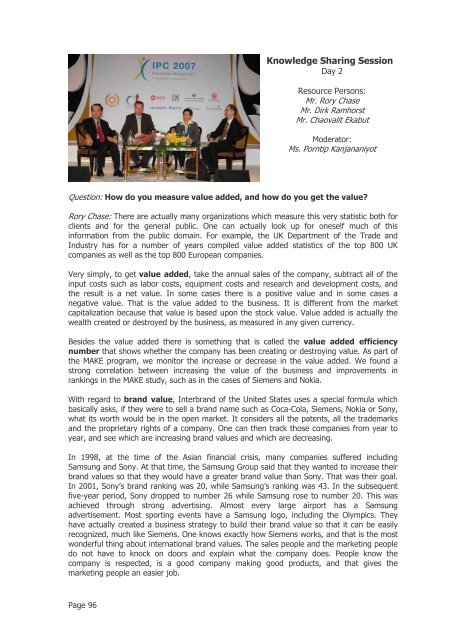Knowledge Management: From Brain to Business (PDF 5.5 - Asian ...
Knowledge Management: From Brain to Business (PDF 5.5 - Asian ...
Knowledge Management: From Brain to Business (PDF 5.5 - Asian ...
Create successful ePaper yourself
Turn your PDF publications into a flip-book with our unique Google optimized e-Paper software.
Page 96<br />
<strong>Knowledge</strong> Sharing Session<br />
Day 2<br />
Resource Persons:<br />
Mr. Rory Chase<br />
Mr. Dirk Ramhorst<br />
Mr. Chaovalit Ekabut<br />
Modera<strong>to</strong>r:<br />
Ms. Porntip Kanjananiyot<br />
Question: How do you measure value added, and how do you get the value?<br />
Rory Chase: There are actually many organizations which measure this very statistic both for<br />
clients and for the general public. One can actually look up for oneself much of this<br />
information from the public domain. For example, the UK Department of the Trade and<br />
Industry has for a number of years compiled value added statistics of the <strong>to</strong>p 800 UK<br />
companies as well as the <strong>to</strong>p 800 European companies.<br />
Very simply, <strong>to</strong> get value added, take the annual sales of the company, subtract all of the<br />
input costs such as labor costs, equipment costs and research and development costs, and<br />
the result is a net value. In some cases there is a positive value and in some cases a<br />
negative value. That is the value added <strong>to</strong> the business. It is different from the market<br />
capitalization because that value is based upon the s<strong>to</strong>ck value. Value added is actually the<br />
wealth created or destroyed by the business, as measured in any given currency.<br />
Besides the value added there is something that is called the value added efficiency<br />
number that shows whether the company has been creating or destroying value. As part of<br />
the MAKE program, we moni<strong>to</strong>r the increase or decrease in the value added. We found a<br />
strong correlation between increasing the value of the business and improvements in<br />
rankings in the MAKE study, such as in the cases of Siemens and Nokia.<br />
With regard <strong>to</strong> brand value, Interbrand of the United States uses a special formula which<br />
basically asks, if they were <strong>to</strong> sell a brand name such as Coca-Cola, Siemens, Nokia or Sony,<br />
what its worth would be in the open market. It considers all the patents, all the trademarks<br />
and the proprietary rights of a company. One can then track those companies from year <strong>to</strong><br />
year, and see which are increasing brand values and which are decreasing.<br />
In 1998, at the time of the <strong>Asian</strong> financial crisis, many companies suffered including<br />
Samsung and Sony. At that time, the Samsung Group said that they wanted <strong>to</strong> increase their<br />
brand values so that they would have a greater brand value than Sony. That was their goal.<br />
In 2001, Sony’s brand ranking was 20, while Samsung’s ranking was 43. In the subsequent<br />
five-year period, Sony dropped <strong>to</strong> number 26 while Samsung rose <strong>to</strong> number 20. This was<br />
achieved through strong advertising. Almost every large airport has a Samsung<br />
advertisement. Most sporting events have a Samsung logo, including the Olympics. They<br />
have actually created a business strategy <strong>to</strong> build their brand value so that it can be easily<br />
recognized, much like Siemens. One knows exactly how Siemens works, and that is the most<br />
wonderful thing about international brand values. The sales people and the marketing people<br />
do not have <strong>to</strong> knock on doors and explain what the company does. People know the<br />
company is respected, is a good company making good products, and that gives the<br />
marketing people an easier job.
















